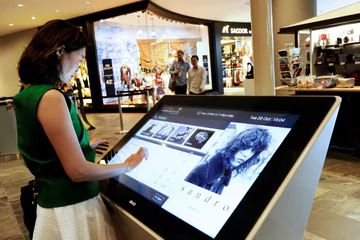Abstract:
In the modern era of conferences and meetings, digital signage has emerged as a powerful tool for enhancing engagement, efficiency, and overall experience. This blog delves deep into the significance of digital signage in conference events and meeting rooms, exploring its multifaceted benefits and impact on participants, organizers, and stakeholders. From facilitating navigation and communication to delivering dynamic content and branding opportunities, digital signage has become an indispensable asset in fostering seamless interactions and maximizing the potential of gatherings. Through comprehensive analysis and real-world examples, this blog elucidates why integrating digital signage into conference events and meeting rooms is not just advantageous but essential in today’s interconnected world.
Introduction:
In the bustling landscape of conference events and meeting rooms, where information flow is constant and interactions are dynamic, the role of digital signage has evolved from being merely supplemental to indispensable. Gone are the days of static signage and paper schedules; today, digital signage stands as a beacon of innovation, transforming how participants engage, navigate, and interact within these environments. In this blog, we delve into the profound importance of digital signage in conference events and meeting rooms, exploring its myriad benefits and the transformative impact it brings to the table.
Enhancing Navigation and Wayfinding
In the sprawling venues of conference events, navigating through labyrinthine corridors and locating specific sessions can often be a daunting task for participants. Here, digital signage emerges as a savior, offering intuitive wayfinding solutions that streamline navigation and eliminate confusion. By strategically placing digital displays at key junctions and entry points, organizers can provide real-time directions, interactive maps, and session schedules, empowering attendees to navigate with ease and efficiency. Moreover, digital signage allows for dynamic updates and instant alerts, ensuring that participants are always informed about changes in schedules, room assignments, or important announcements.
Facilitating Information Dissemination
One of the primary functions of conference events is to disseminate information effectively to a diverse audience. Traditional methods, such as printed agendas and static posters, often fall short in capturing attention and conveying dynamic content. Digital signage revolutionizes this aspect by offering a dynamic platform for information dissemination. Whether it’s showcasing speaker profiles, highlighting session topics, or displaying live updates from social media feeds, digital displays grab attention and deliver information in a visually engaging manner. This not only enhances the visibility of key messages but also fosters greater engagement among participants, who can interact with content in real-time.
Enabling Sponsorship Opportunities and Branding
For organizers, securing sponsorships and maximizing branding opportunities are crucial aspects of conference events. Digital signage serves as a versatile tool in this regard, offering innovative ways to showcase sponsors’ logos, advertisements, and promotional content. From branded welcome screens and sponsored sessions to interactive digital displays featuring sponsors’ products, organizers can create immersive brand experiences that resonate with attendees. Moreover, digital signage allows for targeted messaging and personalized content delivery, enabling sponsors to reach their intended audience more effectively and measure the impact of their investments.
Enhancing Engagement and Interaction
At the heart of every successful conference event lies the engagement and interaction between participants, speakers, and organizers. Digital signage plays a pivotal role in fostering these interactions by facilitating audience engagement, Q&A sessions, and real-time polls. Interactive kiosks and touch-enabled displays empower attendees to interact with content, submit questions, and provide feedback, thereby enriching the overall conference experience. Furthermore, digital signage can be integrated with mobile apps and event management platforms, creating seamless synergy between physical and digital interactions and enhancing the connectivity of participants.
Conclusion and Future Outlook
In conclusion, the integration of digital signage into conference events and meeting rooms represents a paradigm shift in how information is communicated, experiences are enhanced, and interactions are facilitated. From enhancing navigation and information dissemination to enabling sponsorship opportunities and fostering engagement, digital signage has become an indispensable asset for organizers, participants, and sponsors alike. Looking ahead, the future of digital signage in conference events holds immense promise, with advancements in technology paving the way for more immersive, interactive, and personalized experiences. As conferences continue to evolve in the digital age, embracing the transformative power of digital signage will be key to unlocking new possibilities and redefining the way we connect, communicate, and collaborate.
Find more related topic on digital signage display:
- A Dive into the World of Digital Signage with ENRG
- Digital Signage: Enhancing Customer Engagement and Driving Business Growth
- Leveraging Digital Signage to Target B2B Audiences
- Enhancing Spaces: The Transformative Power of Digital Kiosks
- The Evolution of Digital Signage Displays: From Static to Interactive Experiences
- Exploring the World of Self-Information Kiosks: Revolutionizing User Interaction
- Energizing Spaces: The Transformative Impact of ENRG Digital Kiosks in Modern Environments
- The Transformative Power of Digital Standees: Revolutionizing Business Communication











